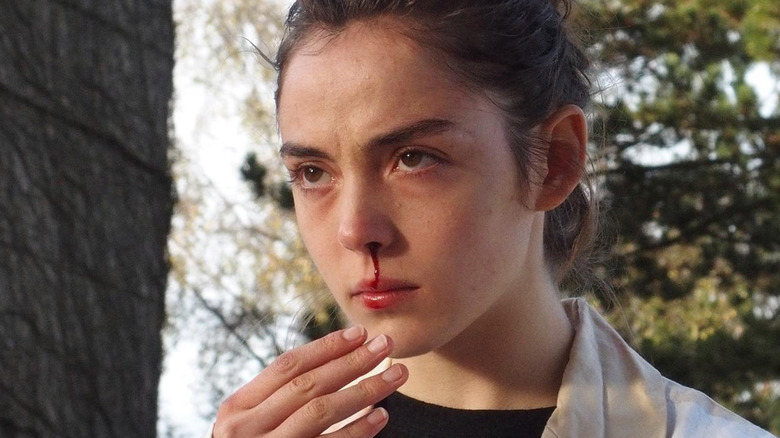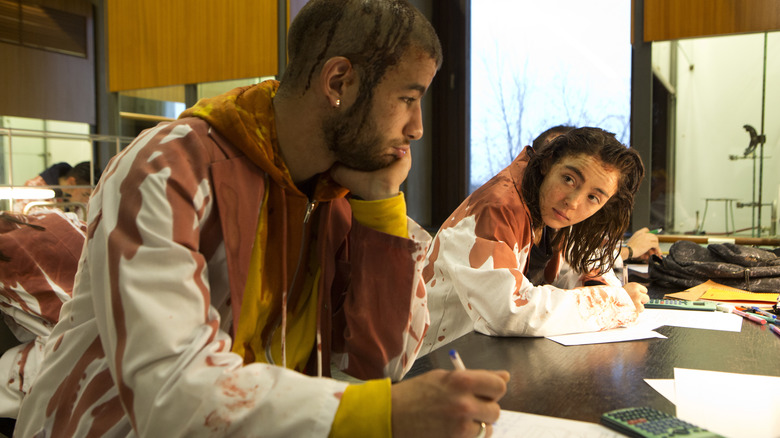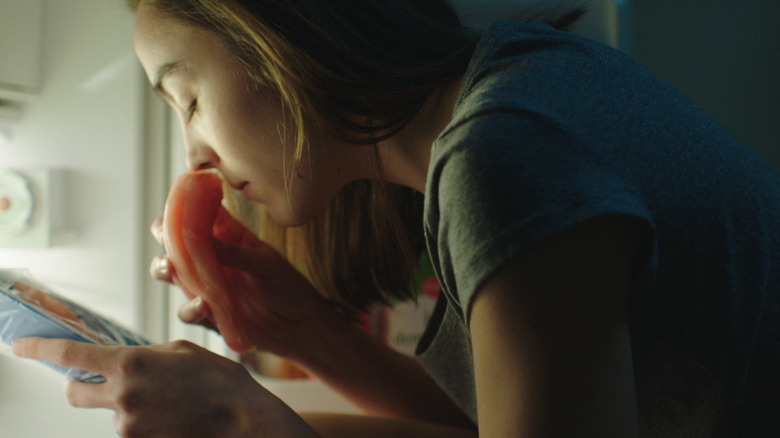One Of Raw's Most Disturbing Scenes Was Much More Real Than You Think
Director Julia Ducourneau doesn't consider her 2016 film "Raw" a horror film. Rather, she sees it as a frank — if perhaps extreme — view of human bodies, our relationship to them, and how much we are driven by our appetites. In an interview with The Guardian, she seemed a little wearied by the sensationalism that sprung up around the film, and resented some critics' descriptions of "Raw" being a feminist parable or tale of terror. Instead, she patiently explained, this is what human bodies are like. We have functions we cannot control — she brings up having a rash — and we are at the mercy of our appetites. Biting is an impulse we all have, she says, but we don't eat other people because we have morality. Ducourneau is the child of a dermatologist and a gynecologist, and she cites her parents' detached view of human bodies as an influence; doctors look at human bodies and even death with a clinical fascination. Messy, fascinating, gross, and necessary.
"Raw" is one of the best films of 2016. It tells the story of a young veterinary student named Justine (Garance Marillier) who has been raised as a strict vegetarian by her parents; in an early scene, they are shocked to learn she might have eaten a hot dog. During a strange a brutal hazing ritual at school, Justine is coated in animal blood and forced to eat a raw rabbit kidney. This awakens something in her appetite, and she finds herself drawn more and more to raw meats and blood and flesh ... and human flesh. This is presented with the bloody frankness that is shocking, yes, but also weirdly, relaxingly clinical.
Ducourneau's frank look at flesh and bodies leads to several scenes wherein we see groups of veterinary students studying, including one shocking scene of a horse being tranquilized ... that may more realer than one might expect.
The Horse Scene
Early in the film, students are being taught how to properly sedate a horse. Horses are typically sedated with ketamine, and sedating them is a common medical practice. In order to film the scene, Ducourneau found an actual veterinary school that was scheduled to sedate a real horse, and asked permission to film it. The cast was invited to watch the sedation in progress. For those averse to seeing animals in peril on film, the scene is harrowing. A real horse, actually under the influence of anesthesia, goes limp and collapses. The horse was not harmed, of course, and everything was handled ethically and humanely, but most film audiences are unlikely to have experience sedating horses, so the scene plays out to many as horrific or at least surprisingly out of the ordinary.
I recall at least one critic — which one, however, is gone from my memory — that compared the scene to the 1903 documentary short "Electrocuting an Elephant" shot by the Edison company. That notorious short film features an elephant named Topsy, as the title describes, being electrocuted to death. The elephant had been sentenced to death after killing three people, and her execution was an early instance of using electricity as a death tool. The film made its rounds through the darker recesses of the cult movie circuit, showed up in "Mr. Mike's Mondo Video," and was featured in Errol Morris' 1999 documentary "Mr. Death: The Rise and Fall of Fred A. Leuchter, Jr."
This is not what Ducourneau wanted to evoke.
We're All Equal With Our Bodies
That the horse scene plays as horrific at all is one of Ducourneau's pet peeves. She is not trying to scare the audience by depicting a horse collapsing, but showing that we are at the mercy of our bodies; We can consider ourselves to be wise, calm, and enlightened, but we still have to pee. In the Guardian article, Ducourneau points out that weeping is not a beatific exercise reserved for saintly Catholic figureheads, but a messy, emotional outpouring of snot and tears. The horse scene is truth. Indeed, it's documentary footage. We may fancy our bodies and strong and organized, but introduce ketamine into the equation, and you too will collapse under your own weight.
Perhaps Ducorneau's storytelling was too, well, raw for some audiences. Tales of people fainting during "Raw" screenings smack of being apocryphal, but the scene is shocking nonetheless. Sometimes, we cannot control our bodies. This is not a dark revelation, but the mere opening thesis of Ducourneau's film. We have no control, and now we can move forward with a tale that will then delve into how we navigate our lives with the constant need to eat, have sex, bite, touch, bite, cry, and bite.
This year, Ducourneau released a new film, "Titane," which also deals with bodily autonomy and dark impulses and appetites, but delves into much more complex territory, involving themes of how our body shapes our identity, how our bodies lead others to make assumptions about us, and how our bodies are increasingly incidental — and yet the most important thing — when it comes to deciding who we are. More than anything, it's about how our bodies will always contain a heart.
"Titane" is a complicated movie — and a great one — and a viewing of "Raw" will help you through.


